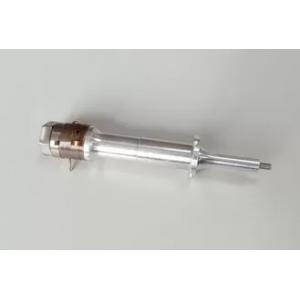

Add to Cart
| Item | Frequency | Impedance | Capacitance |
| 2055-4z | 55khz | 30 | 3500pf |
Ultrasonic bone cutting knife makes it the preferred tool for
leading surgeons who want high performance every time. Ultrasonic
bone cutting knife leaves elastic soft tissues largely unaffected
while efficiently slicing through crystalline bone. The
revolutionary ultrasonic technology amplifies electrical signals
that are then converted into a high-speed back-and-forth motion of
the blunt blade.
The ultrasonic tool provides the ability to make large challenging
osteotomies with ease without compromising safety. The speed to
which the device cuts through bone allow users to maintain short
operative times while improving the overall efficiency of the
procedure.
Ultrasonic bone cutters have much higher requirements for
ultrasonic transducers than ordinary transducers. Ultrasonic
transducers must meet the requirements of: light weight, high
amplitude, and small volume. This 55K piezoelectric ceramic
transducer is specially designed for ultrasonic osteotomy blades
for medical applications. It can reach an amplitude of 30um. After
the output of the horn is amplified, it can reach an amplitude of
60um. However, for high-amplitude vibration, ultrasonic tools The
material requirements of the head are relatively higher.
Ultrasonic bone-cutting devices are new cutting tools and have low
frequency ultrasonic blade. There is limited data on the safety and
effectiveness of using ultrasonic bone-cutting devices in the
treatment of adult spinal deformities.
An ultrasonic bonecutting device is safe in the adult spinal
deformity population and to compare its effectiveness in blood loss
reduction by using a comparison group from a prospective
multicenter database of adult spinal deformity patients.
Why RPS-SONIC TRANSDUCER:
1. Every transducer with a only tracking number, you can check the
parameter from our saler no matter how long it passed.
2. All transducer with one year warranty.
3. Specialized in ultrasound for more than ten years
4. Every transducer with 24hours old testing before shipment.
5. Good packing, no packing problem during the 10 years exporting
business.
6. Every customer will get purchase records and there are certain
rewards after accumulation
Service and shipment
Piezosurgery is an innovative osteotomy technique using
piezoelectric ultrasonic vibrations. Ultrasonic vibrating
instruments for cutting mineralized tissue have been reported since
the 1950s In 1988, Italian oral sugeon, Tomaso Vercellotti,
developed a piezoelectric osteotomy device, which provided the
opportunity for the widespread clinical use of piezosurgery
Currently, piezoelectric devices are used widely for osteotomies,
such as maxillary sinus lift, impacted mandibular third molar
extraction, and bone grafting, in the field of oral and
maxillofacial surgery.
The major advantage of piezosurgery is its selective cutting of
mineralized bone. Frequencies higher than 50 kHz are needed to cut
soft tissues. The piezoelectric device is designed to produce
ultrasonic microvibrations of 60-210 μm at a frequency of 25-30
kHz. Thus, piezoelectric devices, different from conventional
rotary instruments and microsaws, are able to cut only mineralized
tissues. Therefore, piezosurgery can reduce considerably the risk
of damage to adjacent soft tissues, such as blood vessels, nerves,
and mucous membranes, in cases of osteotomy. Other advantages of
piezosurgery include reduction of overheating resulting from the
generation of a cavitation effect and better visibility of the
surgical area due to less bleeding. Moreover, use of piezosurgery
for extraction of the impacted mandibular third molar was reported
to produce less facial swelling and trismus postoperativily
compared to that of rotary osteotomy. Recent studies on the healing
of bone defects experimentally created by piezosurgery demonstrated
no difference in the newly formed bone volume and the healing
process between piezosurgery and conventional osteotomy techniques.
Meanwhile, piezosurgery was shown to have a longer surgical time
than conventional osteotomie.
